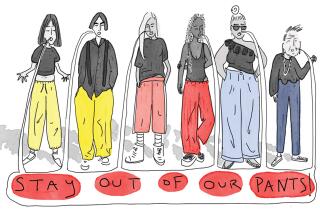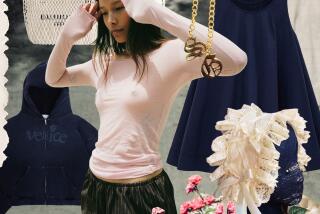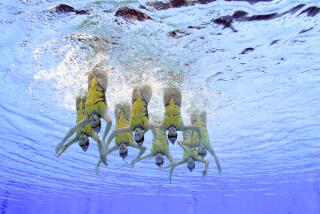In swimwear, tribal styles make waves
Our choice of swimwear is frequently less about making a fashion statement and more about trying to find something that flatters the body and doesn’t require a towel around the waist to complete the ensemble. Many of us opt not to shop for a new suit, season after season, to avoid confronting our physical flaws — and the agony of dressing room lighting.
Nonetheless, the swimwear industry has managed to weather the down economy, reporting $4 billion in sales in 2009, down only slightly from 2008. Marshall Cohen of NPD Group, a New York-based market research firm, says that sales are staying relatively strong because of the shift in the way people are vacationing (“staycations” and nearby getaways) and their ability to purchase swimsuits online.
And now, with manufacturers selling swimwear as mix-and-match separates, a woman can customize the fit and shape of the bathing suit that best fits her body. So being a size 4 on top and a 12 on the bottom no longer makes finding a suit that fits impossible. “When separates became available in stores and online, it gave consumers the ability to custom build,” says Cohen.
And there’s more good news for consumers: This year, stores are awash with bikinis, one-pieces, bandeaus, underwire cups and coverups in vivid prints, angular shapes and patterns that can accentuate rather than reveal.
The resurgence of one-piece suits means that belly-baring isn’t mandatory. Swimwear lines such as Kooey, Eres and We Are Handsome, and designers such as Diane von Furstenberg are creating suits with asymmetrical straps, bold cut-aways and strong ‘70s graphics splashed across the front for a “look-at-me” quality that doesn’t cross the line into “extreme” territory.
Shoppers may also encounter the bright, athletic-inspired trend that appeared on the runways of Proenza Schouler and Versace, and that translates into beachwear, including zip-front neon one-pieces à la 1980s Body Glove from lines such as Cynthia Rowley for Roxy. (All that’s missing is the pink, yellow and blue Maui & Sons surfboard.)
But the strongest trend in swimwear this season may be a look best described as tribal, seemingly inspired by the animal prints, raffia, ikat (a method of weaving that is reminiscent of tie-dye) and ethnic style embroidery seen on the runway at Dries Van Noten, Von Furstenberg and Catherine Malandrino. The look is eclectic and sophisticated but is playful enough for beach and pool wear.
Max Osterweis, creative director of the New York-based line Suno, which includes swimwear, started his clothing line after 14 years of collecting vintage kangas from Kenya. The bright fabrics were used to build his first collection for spring 2009, and now the line is almost entirely produced by craftsmen and tailors in Kenya who draw on their local techniques and resources.
“Ikats, tie-dyes and kangas are quite beautiful, and people have been going back to them [for] hundreds and thousands of years,” says Osterweis. “They’ll keep coming back because they’re inspirational and worldly and a good way for women to exude different aspects of their style.”






